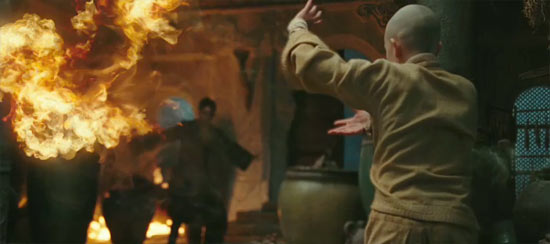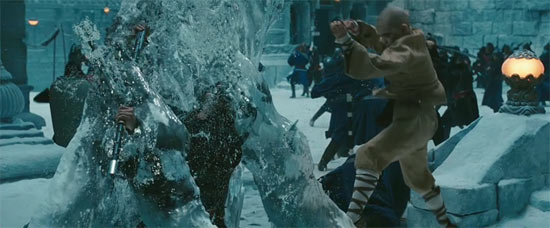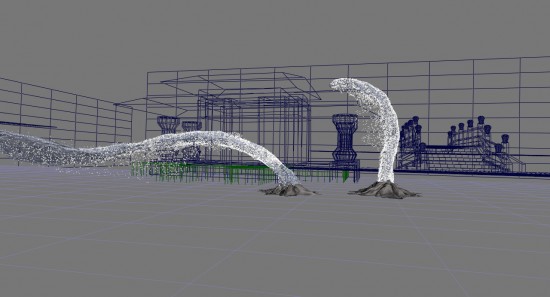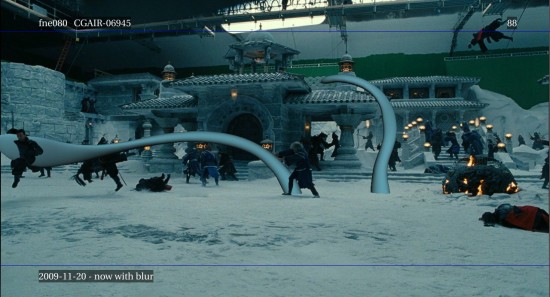ILM Visit: The Last Airbender
I'm a late Avatar convert. It took months of being assaulted by the plaudits of critics and audiences until I was even ready to entertain the notion that a Nickelodeon show could actually be deserving of such praise, and several more months after having watched it to wipe clean the shame I felt for not taking note earlier. Once I actually forced myself to sit down and check out the first few episodes, I was hooked, and not even two weeks later, I had finished the entire series. My transformation was complete; I had become a devout Airbender fanatic. And as a devout Airbender fanatic, it became my duty to give M. Night Shyamalan as much shit as possible for every misstep he would undoubtedly make in adapting the series for the big screen.
After my visit to Industrial Light & Magic though, he's made that task just a little bit harder.

photo credit: odonata9
Allow me to set the scene: ILM is a movie geek wonderland. On the outside, it seems like a fairly typical company, only bigger. You might even confuse it for a college campus, if college campuses were ever as fastidiously maintained as they appear in their ads, and if any of them were cool enough to have a water fountain mounted with a stone Yoda overlooking the premises. Once inside the lobby, visitors are greeted by life-size replicas of classic Star Wars characters like Darth Vader, Boba Fett, and Imperial Stormtroopers, as well as an overwhelming amount of Star Wars memorabilia, including authentic lightsaber models. The real thrill though, is in exploring the rest of the building, which feels less like a place of work than a labyrinthian museum detailing the history of visual effects. Scattered throughout the halls–all of which are fully decked with vintage posters of films that the company has worked on–are a variety of original props, models and artwork, ranging from the Vigo painting in Ghostbusters II to a full-scale velociraptor from Jurassic Park.
As fascinating as it was to tour the facilities though, that's not why we were there. /Film was invited, along with a handful of other journalists, to head down to ILM's San Francisco-based headquarters so that we could get an inside look at the post-production process of The Last Airbender, giving us some insight into the work that went into creating the film's visual effects-laden world.
Instead of simply going through a standard breakdown of what we did, what we saw, and who we spoke to, I'm going to simplify things a bit by focusing on my impressions of the footage shown and any interesting tidbits derived from it, broken down into four categories.
 Elemental FX
Elemental FX
Considering how notoriously awful CGI fire and water has been in the past, it's astonishing how beautifully and believably rendered they are in The Last Airbender. Our first demonstration of this was in a clip recreating the intro of the show, highlighting the four elemental abilities in action.
According to the film's tech department (Craig Hammack – Associate VFX Supe, and Daniel Pearson – Digital Production Supe), the look of the fire was one of M. Night's main concerns. He was aware of how fake digitally-created fire usually looks, and because these are films where digital fire is a necessity, a lot of time was spent perfecting how the fire would play on-screen.
Another of M. Night's concerns was that he didn't want to venture too far into fantasy. In the series, the fire benders are the sole group that can generate their respective element without an originating source. In a bid to keep the show more grounded in reality, M. Night altered the show mythology so that the fire benders would no longer be able to create fire from nothing. My immediate fear was that this would diminish the treat of the Fire Nation–after all, fire is not nearly as readily available as air, earth and water–but it looks as though they've come up with some creative work-arounds to make sure that the Fire Nation always has a flame close at hand.
Air bending, meanwhile, posed a very different problem. Since it exists everywhere but isn't explicitly visible, there was a question of how much the audience should see. Ultimately, they went for a "gaseous air look", and put more emphasis on how the air bending would affect the location around it. So if an area were particularly dusty, the air bending effect would be conveyed more through the way the dust is picked up off the ground than the actual air itself.
With all of the elements, the common theme throughout was that they should always feel like an extension of the actor/character. When Katara is practicing with water bending early on, she's still inexperienced, so a water ball she creates is sloppy and drips around the edges. M. Night was very committed to the idea that the bending abilities are a part of the character, and it was important for the animators to stay true to that by using the actor's performance to measure how the bending effects would appear.
 Action Sequences
Action Sequences
If you've watched any of the trailers, you've already gotten a taste of the film's combat, but what hasn't yet become apparent is that almost all of the action beats are taken from single-shot sequences.
Take the above image, for example. That shot doesn't begin and end with Aang flipping over and freezing the guy. The actual scene is closer to a minute long, and it consists of one continuous take of Aang using both of his air and water abilities to blast through, dodge under, and disable the swarm of enemies surrounding him.
All of the action scenes are like this, and they look incredible.
If nothing else, I have complete confidence that The Last Airbender will deliver on a level of pure spectacle, highlighting the benefit of a wide frame and minimal cutting. I still have my reservations about the story, dialogue and acting, which we understandably saw little to none of in the many visual FX-oriented clips shown to us, but at least I can rest easy knowing the film has done justice to the show's fantastically choreographed fight sequences.
Amusing side note: That's not actually Noah Ringer in the aforementioned clip. It's his female stunt double, who was used frequently for the more strenuous feats. Her face has been replaced with Ringer's in post-production.
 Appa, Momo and Other Creatures
Appa, Momo and Other Creatures
Two of the show's most beloved characters have been all but omitted in the film's marketing materials, so it was with overwhelming excitement and mild trepidation that I received my first glimpse of these entirely digital creations.
Truthfully, I'm still a little uneasy. Based strictly on the brief footage I saw, the photorealistic attempt at updating these characters seems to have taken away some of their charm. They're faithful recreations, but something about them feels off.
Momo looks almost exactly like a real lemur, or at least as close as you can get with CGI. Obviously though, he isn't just a normal lemur: he's got big, pointy ears, and can fly. The animation department (Tim Harrington – Animation Supe) explained how they worked out the mechanics of Momo's flight using the Giant Fruit Bat, and decided to conceal his wings when not in use by having them fold up under his arms.
As for Appa, Harrington says he envisioned him as kind of a combination of Chewbacca and the Millennium Falcon. "He's this hairy sidekick, but he's also the kids' ride from location to location." For his design, they opted for polar bears, elephants and bison as reference points, but decided to steer away from using bison and cows for the face since they didn't want to make him look like he's dumb. Instead, they tried to find a comfortable balance between animal and human, basing his facial appearance off primates.
Other creatures in the film include Avatar Roku's Spirit Dragon, the Komodo Rhinos, and a koi fish. For the Spirit Dragon, which guides Aang in the spirit world, they went for a serpentine approach, favoring Eastern flair over a strictly traditional Chinese dragon. And with the Komodo Rhinos, which the Fire Nation use to climb up walls when riding into battle, they tried to capture the unruly walk of a bulldog.
That's all for the creatures in this movie, but it was hinted that a ton of other creatures would be appearing in the sequel.
 Environmental Design
Environmental Design
As with everything in The Last Airbender, great attention was paid to basing the world in reality as much as possible, and this is especially true of the landscapes featured in the film. Real world temples from India and China were photographed and used as a base for the air temples, which were then set atop unreachable rock landscapes.
The film's art department (Christian Alzmann – Art Director, Barry Williams – Digital Matte Artist) explained how M. Night always used the word "masculine" when describing what the environments should look like, and that they should have a dark, realistic edge. "He was always pushing us to make it a little more ominous."
When presented with a concept visualization of one of the background shots, M. Night decided to limit the CGI spectacle of it in favor of a much more toned down look, as to not distract from the emotional state of the characters. It was important that the environments and locations be visually compelling, as with the industrial style of the Fire Nation's ships, but they should always be at the service of what the characters are feeling.
To close off, here's a four-part visual FX deconstruction of a shot from the film, courtesy of Industrial Light & Magic.



 The Last Airbender opens in theaters on July 1st.
The Last Airbender opens in theaters on July 1st.
